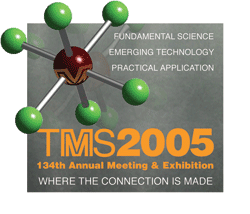|
|
FEBRUARY 13-17 · 2005 TMS ANNUAL MEETING · SAN FRANCISCO, CALIFORNIA
 Integrating Lean and Six Sigma in an Aluminum Smelter Integrating Lean and Six Sigma in an Aluminum Smelter
Sponsored by: TMS Light Metals Division
Dates and Times: Sunday, February 13, 2005 ~ 8:30 am-5:00 pm
Advance Fees: Members $475; Non-Members $560. If you register by January 17, 2005 you will save an additional $50.00.
To register for a course, please use the 2005 TMS Annual Meeting Registration form. You may register any time prior to the Annual Meeting and on-site. Course size is limited and a sufficient number of pre-registered attendees are necessary to offer each course, so please register early!
Who Should Attend
This one-day course is intended for managers, engineers,
maintenance, and operations personnel who are
accountable for daily operations and rapid process improvement.
Those seeking an introduction or review of
the principles, methods and tools of an integrated Lean
and Six Sigma approach with a specific focus on smelter
applications, will benefit from this hands-on workshop.
Course Overview: A Hands-on Simulation
In recent years, Lean Manufacturing and Six Sigma have
come to the forefront as models for manufacturing excellence.
Six Sigma is driven by the fact that process and product
variation is known to be a strong factor affecting manufacturing
lead times, product and process costs, process yields,
product quality, and ultimately business value. A crucial part
of 6S work is to define and measure variation with the intent
of discovering its causes and to develop efficient, operational
means to control and reduce the variation. The expected
outcomes of 6S efforts are faster flow, more efficient and
capable manufacturing processes, and more consistent,
predictable and capable overall business performance
Lean Manufacturing (based on the Toyota Production System)
is focused on the elimination of waste in all aspects of the
process, leading to reduction in process variability, reduction
in system cycle times, creating fast and flexible product flow
and creating value in use of the product by the customer.
This hands-on aluminum smelter simulation enables participants to experience first hand the basic principles, methods and tools of both Six Sigma and Lean and how they apply, specifically in a continuous and batch processing environment.
-
How to align process improvement efforts with
business objectives and target the right critical
processes through Process Mapping
-
The need for integrating essential improvement
strategies: Lean (time based) and Six Sigma
(variation based)
-
How this integrated approach will help you leverage
efforts to eliminate waste and create the greatest
value for you and your customers
-
How to reduce process variation to increase
throughput, reduce inventory and lower cost
-
How to define and use appropriate data for both daily
process management and rapid process improvement
-
How to effectively involve people at all levels of the
organization in fighting waste and moving toward Lean
Through running and analyzing the factory simulation,
participants will learn how the tools of Lean and Six Sigma
can be successfully integrated into a wider framework
to deliver sustained business value through, increasing
throughput, reducing inventory, improving product quality,
reducing cost and improving reliability of supply.
The hands-on aluminum smelter simulation is complete
with customer orders for varied products, bulk raw
materials, “continuous” production lines, post-production
processing and batch production centers and introduces
the Integrated Lean and Six Sigma Methods and Tools:
-
Basic statistical methods to analyze and improve
the process
-
Designed Experiments to study and test improvements
-
Statistical Process Control and Response for daily control
-
Stability in the value stream through Visual 5S and
Standardized Work
-
Flow and Pull in an Aluminum Smelter
-
Accelerate Flow and increase throughput through
variation reduction and process streamlining
Learn the power of integrating Lean and Six Sigma in an
aluminum smelter through this hands-on factory simulation,
illustrating the full benefits that can be delivered.
About the Presenters
Keith
Sinclair is
a process improvement consultant with 18 years experience helping businesses
achieve measurable improvement through the principles, methods and tools
of what today is referred to as Six Sigma integrated with Lean Manufacturing.
In addition to his consulting work, Keith’s experience
includes engineering, manufacturing management, and applied
statistics. He founded Sinclair Associates, Inc. in 1986.
Keith has taught hundreds of process improvement practitioners
and managers and lead programs and projects with demonstrated
and significant ROI. His industrial experience includes
industrial and process engineering as well as manufacturing
management in a wide range of manufacturing and processing
industries including mining, chemicals, steel, automotive supply,
electronics, metal processing and assembly. In the past 12 years
he has worked extensively in continuous and batch processing
industries. His client list includes small, privately held companies
to large international firms, with clients in the USA, Europe,
Asia, Australia, South America, and Southern Africa.
Rick
Phelps is an industrial engineer with 23 years of experience
in applying the Theory of Constraints (TOC) to a
wide range of industrial problems both as a practitioner and
as a consultant. Trained and experienced in applied industrial
statistics as well as the ‘Lean’ toolkit, Rick has helped numerous
manufacturing enterprises focus their efforts and improve
their critical processes and their bottom lines.
Interrupting his industrial career for three years, Rick
served as a Habitat for Humanity International Partner in
Uganda, where he found plenty of novel applications for
his talents at process improvement. For this humanitarian
outreach, Rick was honored in 1998 as an Outstanding
Young Alumnus by The Georgia Institute of Technology.
For
More Information
Christina Raabe
TMS, Manager of Continuing Ed and Information
184 Thorn Hill Road
Warrendale PA 15086 USA
Tel (724) 776-9000 ext. 212
Fax (724) 776-3770
E-mail raabe@tms.org
|

